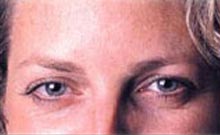
Surgery is the treatment for patients with congenital ptosis. The procedure can involve either shortening the levator muscle or attaching it to the muscles of the brow. In instances of acquired or levator dehiscence ptosis, the doctor first determines the cause of the problem. If ptosis is a result of muscle or nerve disease, the doctor will begin by treating the disease first. If a tumor is the cause, it can sometimes be removed. In some cases, the doctor may suggest surgery for correction of the condition.
 Before
Before  After
After
Botox is a toxin, responsible for the condition botulism. It blocks nerve impulses to muscles by blocking the receptor site for the appropriate neurotransmitter. Botox is a popular treatment for:
 Before
Before  After
After
Botox, is approved by the FDA and has been shown to be safe and effective for these conditions.
Suitability– Botox is a tried and tested treatment for the above mentioned list of conditions.
Benefits– Effectively does away with eyelid spasm.
Blepharoplasty is the medical term for Eyelid surgery and it is a procedure used to remove excess skin from the upper and lower eyelids. This procedure can help you correct drooping upper lids or puffy bags below your eyes. These are features that make you look older than you feel, and may even sometimes interfere with your vision.
Distinction– Blepharoplasty can enhance your appearance and improve your self-confidence.
 Before
Before  After
After
Suitability– The ideal candidates for blepharoplasty are men and women who are physically healthy, psychologically stable, and realistic in their expectations. Most patients who undergo this surgery are thirty five or older.
Blepharoplasty is risky in patients with hypothyroidism, Graves’ disease, dry eye or lack of sufficient tears, high blood pressure or other circulatory disorders, diabetes, and cardiovascular disease. A detached retina or glaucoma is also a cause for caution.
Copyright © 1987-2024 Ojas Eye Hospital All rights reserved | Privacy Policy
*Disclaimer: All information on www.lasikindia.com for informational purposes only and is not intended to be a substitute for professional medical advice, diagnosis, or treatment. Always seek the advice of your physician or other qualified health care provider.